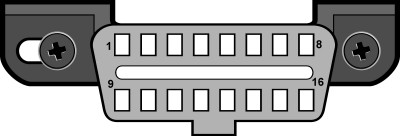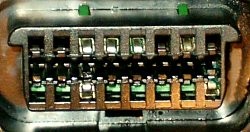Determining whether your vehicle is OBD2 compliant is crucial for modern car diagnostics and maintenance. OBD2, or On-Board Diagnostics II, is a standardized system that allows you to access your vehicle’s health information using a scan tool. Understanding if your car supports OBD2 is the first step in using these tools effectively. This guide will help you figure out “Is My Vehicle Obd2” compliant and what that means for you.
Understanding OBD2 and Why It Matters
OBD2 was mandated in the United States for all cars and light trucks starting in 1996. This standardization was primarily driven by environmental regulations, aiming to monitor vehicle emissions and ensure they meet set standards. However, OBD2’s benefits extend far beyond just emissions. It provides a wealth of data about your vehicle’s engine, transmission, and other systems, making it invaluable for diagnosing problems and performing maintenance.
For car owners, OBD2 compliance means you can:
- Diagnose Check Engine Light Issues: Read trouble codes to understand why your check engine light is on.
- Monitor Vehicle Performance: Access real-time data about engine temperature, speed, RPM, and more.
- Perform Basic Maintenance: Reset service lights and perform some system resets.
- Potentially Save on Repair Costs: By understanding the issue yourself, you might avoid unnecessary trips to the mechanic for initial diagnostics.
However, OBD2 compliance isn’t universal across all vehicles and regions, especially for older models. Let’s explore how to check if your vehicle is OBD2 compliant.
Quick Compatibility Check: Country of Sale and Model Year
The easiest way to initially determine OBD2 compatibility is by considering where your vehicle was originally sold and its model year. It’s important to note that compatibility is based on the country of sale, not where the car was manufactured.
Here’s a general guideline based on different regions:
-
United States: If your vehicle was sold new in the United States and is a 1996 model year or newer, it is almost certainly OBD2 compliant. This was mandated by US legislation.
-
Canada: For vehicles sold in Canada, OBD2 compliance is generally expected for 1998 model year and newer.
-
European Union (EU): The rules in the EU are a bit more nuanced and depend on the fuel type:
- Petrol (Gasoline) Vehicles: If sold in the EU, petrol vehicles are generally OBD2 compliant from 2001 model year onwards with full compliance from 2002. Limited compliance may exist for some 2001 models.
- Diesel Vehicles: EU diesel vehicles typically achieved OBD2 compliance from 2004 model year onwards, with full compliance from 2007. Limited compliance may be present in models from 2004-2006.
- Important Note on EU: These dates refer to countries that were members of the EU at the time of OBD2 implementation.
-
Australia & New Zealand:
- Petrol Vehicles: OBD2 compliance is common for petrol vehicles sold in Australia and New Zealand from 2006 model year onwards.
- Diesel Vehicles: For diesel vehicles in these countries, OBD2 is generally found from 2007 model year onwards.
-
Other Countries: For countries not listed above, refer to the table below for specific model year guidelines. If your country isn’t listed, consulting your vehicle manual or dealership is recommended.
| Country of Sale | Model Years | Notes |
|---|---|---|
| Algeria | 2014 | |
| Argentina (Domestic) | 2008 | |
| Argentina (Imports) | 2009 | |
| Australia (Diesel) | 2007 | |
| Australia (Petrol) | 2006 | |
| Bahrain | Full OBD-II Compliance for 2018 and onward | Limited Compliance from 2017-18 |
| Brazil (Petrol) | Full OBD-II Compliance for 2007 and onward | Limited Compliance from 2005-06 |
| Brazil (Diesel) | Full OBD-II Compliance for 2015 and onward | Limited Compliance from 2013-14 |
| Chile (Diesel) | 2013 | |
| Chile (Petrol) | 2014 | |
| China (Beijing – Petrol) | 2008 | |
| China (Country – Diesel) | 2011 | |
| China (Country – Petrol) | 2010 | |
| Costa Rica | Limited Compliance from 2017 onward | |
| Hong Kong | 2006 | |
| India | Full OBD-II Compliance for 2017 and onward | Limited Compliance from 2013-16 |
| Iran | 2012 | |
| Israel | 2003 | |
| Japan | Full OBD-II Compliance for 2008 and onward | Limited Compliance from 2003-07 |
| Kuwait | Full OBD-II Compliance for 2018 and onward | Limited Compliance from 2017-18 |
| Mexico | 2007 | |
| Morocco | 2010 | |
| New Zealand (Diesel) | 2007 | |
| New Zealand (Petrol) | 2006 | |
| Nigeria | 2015 | |
| Oman | Full OBD-II compliance for 2018 and onward | Limited Compliance from 2017-18 |
| Peru | 2003 | |
| Peru | 2017 | |
| Philippines | 2016 | |
| Qatar | Full OBD-II Compliance for 2018 and onward | Limited Compliance from 2017-18 |
| Russia | Full OBD-II Compliance for 2012 and onward | Limited Compliance from 2010-11 |
| Saudi Arabia | Full OBD-II Compliance for 2018 and onward | Limited Compliance from 2017-18 |
| Singapore | 2014 | |
| South Korea | Full OBD-II Compliance for 2010 and onward | Limited Compliance from 2005-09 |
| Taiwan | 2008 | |
| Thailand | 2013 | |
| Turkey | 2013 | |
| United Arab Emirates | Full OBD-II Compliance for 2018 and onward | Limited Compliance from 2017-18 |
| Vietnam | 2017 | |
| Yemen | Full OBD-II Compliance for 2018 and onward | Limited Compliance from 2017-18 |


Remember: Hybrid and Electric vehicles may have different diagnostic systems and our scan tools may not be fully compatible. Always check your vehicle manual or consult with your dealer.
Finding the OBD2 Port: The 16-Pin Connector
A key physical indicator of OBD2 compliance is the presence of a standardized 16-pin Diagnostic Link Connector (DLC). This port is usually located within 2 feet of the steering wheel, but its exact location can vary. Common places to check include:
- Under the dashboard, near the steering column
- Below the glove compartment
- In the center console
The OBD2 port is typically trapezoidal in shape, as shown below:
Fig. 1: Standard OBD2 16-pin Diagnostic Connector. This is the typical port you’ll find in OBD2 compliant vehicles.
If you find a 16-pin connector that resembles this, it’s a strong indication that your vehicle might be OBD2 compliant.
Beyond the Connector: Checking for an OBD Compliance Label
Even if you find a 16-pin connector, it’s not a guaranteed confirmation of OBD2 compliance, especially in older European and Asian vehicles. Some manufacturers used 16-pin connectors before fully adopting OBD2.
To be absolutely sure, look for a Vehicle Emission Control Information label under the hood of your car. This label often states whether the vehicle is certified to comply with OBD-II standards.
Fig. 2: Example of a Vehicle Emission Control Information Label. Look for phrases like “OBD II Certified”, “EOBD Compliant”, or “JOBD Compliant” on this sticker.
This label might use terms like:
- OBD II: Referring to the US standard (California ARB).
- EOBD: European On-Board Diagnostics.
- JOBD: Japanese On-Board Diagnostics.
Finding any of these terms on the label confirms your vehicle’s OBD2 (or regional equivalent) compliance.
What if My Car Has a 16-Pin Connector But Isn’t OBD2 Compliant?
It’s less common, but some older vehicles, particularly from European and Asian manufacturers, might have a 16-pin connector that looks like OBD2 but isn’t fully compliant with the standard. These pre-OBD2 connectors often lack full SAE J1979 conformity, the standard that defines OBD2 communication protocols.
Visually, you might notice subtle differences in the connector itself in non-OBD2 compliant vehicles. For example, some may have “ears” or slight variations in shape compared to the standard OBD2 port.
In these cases, a generic OBD2 scan tool may not communicate correctly with your vehicle.
Final Steps: Owner’s Manual and Dealer Consultation
If you are still unsure after these checks, your vehicle’s owner’s manual is a valuable resource. It should specify whether your vehicle is OBD2 compliant.
As a last resort, you can consult your local car dealership. However, be aware that some dealers might not be fully knowledgeable about the nuances of OBD vs. OBD2, especially for older vehicles.
Conclusion: OBD2 Compatibility Empowers Vehicle Diagnostics
Knowing “is my vehicle OBD2” compliant is essential for taking advantage of modern car diagnostic tools. By checking the country of sale, model year, looking for the 16-pin connector and the compliance label, you can confidently determine your vehicle’s OBD2 status. This knowledge empowers you to better understand your car’s health and potentially save time and money on vehicle maintenance.
If you’ve confirmed your vehicle is OBD2 compliant, explore the range of OBD2 scan tools available at techcarusa.com to start taking control of your car’s diagnostics today!

